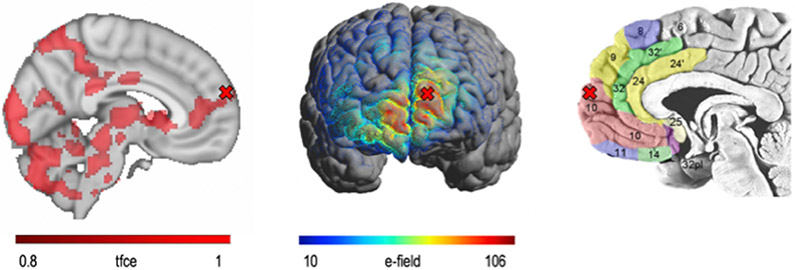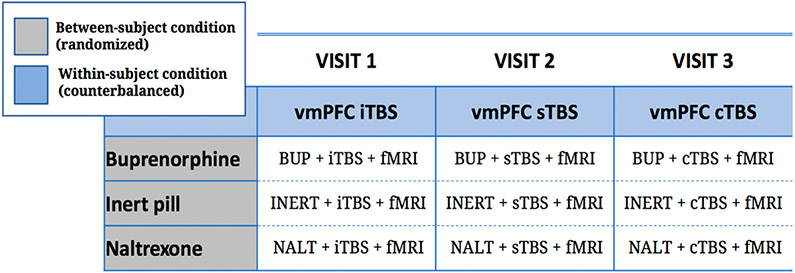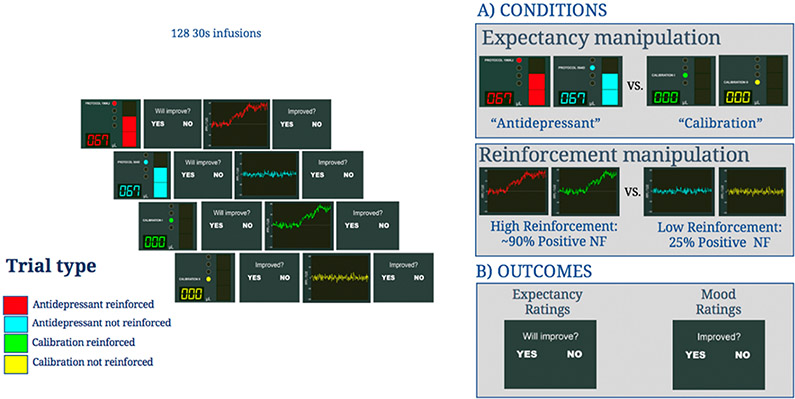了解抗抑郁剂安慰剂效应的神经计算机制
摘要
在过去的二十年里,神经科学家利用抗抑郁安慰剂探针研究了抗抑郁安慰剂效应的生物机制。然而,这些研究结果还没有阐明一种基于模型的理论,来解释抗抑郁剂预期会诱发持续情绪变化的机制。新的证据表明,抗抑郁安慰剂效应可能来自强化学习(RL)模型。这样,随着新的感官证据的到来,个体对改善的预期也会随之更新,其中包含了奖励预测误差(RPE),它是预期(期望值)与感知改善之间不匹配的信号。与这一框架相一致的是,抗抑郁安慰剂效应的神经影像学研究表明,安慰剂会诱导μ-阿片激活,并增加追踪预期值(如腹外侧前额叶皮层(vmPFC))和RPE(如腹侧纹状体(VS))区域的血氧水平依赖性(BOLD)反应。在本研究中,我们将利用针对腹侧前额叶皮层的经颅磁刺激(TMS)和利用药理学方法的μ-阿片纹状体RPE信号来实验操纵预期值,从而证明奖赏学习信号(预期值和RPE)对抗抑郁安慰剂效应的因果关系。我们假设,抗抑郁安慰剂的预期值会在脑前区(vmPFC)表现出来,并通过μ-阿片调节的纹状体学习信号进行更新。在3 × 3因子双盲设计中,我们将把120名未服用抗抑郁药但有抑郁症状的患者随机分配到三种受试者间阿片类药物条件中的一种:μ-阿片类药物激动剂丁丙诺啡、μ-阿片类药物拮抗剂纳曲酮或惰性药丸。在每个实验组中,受试者将被分配接受针对 vmPFC 的三种受试者内平衡形式的 TMS--间歇性 Theta Burst Stimulation (TBS)(预计会增强 vmPFC)、持续性 TBS(预计会减弱 vmPFC)或假 TBS。这些实验操作将用于调节抗抑郁安慰剂功能磁共振成像(fMRI)任务中的逐次试验奖赏学习信号和相关大脑活动,以达到以下目的:(1)研究vmPFC-VS回路中的奖赏学习信号与抗抑郁安慰剂效应之间的关系;(2)研究vmPFC预期值计算对抗抑郁安慰剂效应的因果贡献;以及(3)研究μ-阿片调节的纹状体RPE对抗抑郁安慰剂效应的因果贡献。拟议的研究将首次调查μ-阿片调节的vmPFC-VS学习信号对抗抑郁安慰剂反应的因果关系,为开发调节学习过程的新疗法以及在药物开发过程中量化并可能减少安慰剂效应的客观方法铺平道路:试验注册:ClinicalTrials.gov Identifier:试验注册:ClinicalTrials.gov Identifier:NCT04276259。



Over the last two decades, neuroscientists have used antidepressant placebo probes to examine the biological mechanisms implicated in antidepressant placebo effects. However, findings from these studies have not yet elucidated a model-based theory that would explain the mechanism through which antidepressant expectancies evolve to induce persistent mood changes. Emerging evidence suggests that antidepressant placebo effects may be informed by models of reinforcement learning (RL). Such that an individual's expectation of improvement is updated with the arrival of new sensory evidence, by incorporating a reward prediction error (RPE), which signals the mismatch between the expected (expected value) and perceived improvement. Consistent with this framework, neuroimaging studies of antidepressant placebo effects have demonstrated placebo-induced μ-opioid activation and increased blood-oxygen-level dependent (BOLD) responses in regions tracking expected values (e.g., ventromedial prefrontal cortex (vmPFC)) and RPEs (e.g., ventral striatum (VS)). In this study, we will demonstrate the causal contribution of reward learning signals (expected values and RPEs) to antidepressant placebo effects by experimentally manipulating expected values using transcranial magnetic stimulation (TMS) targeting the vmPFC and μ-opioid striatal RPE signal using pharmacological approaches. We hypothesized that antidepressant placebo expectancies are represented in the vmPFC (expected value) and updated by means of μ-opioid-modulated striatal learning signal. In a 3 × 3 factorial double-blind design, we will randomize 120 antidepressant-free individuals with depressive symptoms to one of three between-subject opioid conditions: the μ-opioid agonist buprenorphine, the μ-opioid antagonist naltrexone, or an inert pill. Within each arm, individuals will be assigned to receive three within-subject counterbalanced forms of TMS targeting the vmPFC-intermittent Theta Burst Stimulation (TBS) expected to potentiate the vmPFC, continuous TBS expected to de-potentiate the vmPFC, or sham TBS. These experimental manipulations will be used to modulate trial-by-trial reward learning signals and related brain activity during the Antidepressant Placebo functional MRI (fMRI) Task to address the following aims: (1) investigate the relationship between reward learning signals within the vmPFC-VS circuit and antidepressant placebo effects; (2) examine the causal contribution of vmPFC expected value computations to antidepressant placebo effects; and (3) investigate the causal contribution of μ-opioid-modulated striatal RPEs to antidepressant placebo effects. The proposed study will be the first to investigate the causal contribution of μ-opioid-modulated vmPFC-VS learning signals to antidepressant placebo responses, paving the way for developing novel treatments modulating learning processes and objective means of quantifying and potentially reducing placebo effects during drug development.
Trial registration: ClinicalTrials.gov Identifier: NCT04276259.

 求助内容:
求助内容: 应助结果提醒方式:
应助结果提醒方式:


